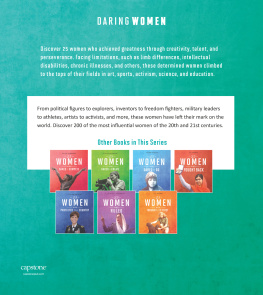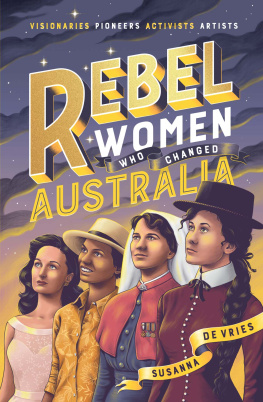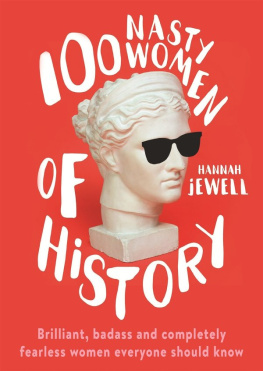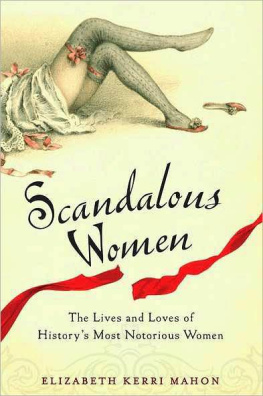 | The ABC Wave device is a trademark of the
Australian Broadcasting Corporation and is used
under licence by HarperCollins Publishers Australia. |
First published in Australia in 2014
This edition published in 2014
by HarperCollins Publishers Australia Pty Limited
ABN 36 009 913 517
harpercollins.com.au
The Big Book of Scandalous Australian Women is a combined edition of Kay Saunders previous books:
Notorious Australian Women (2011)
and Deadly Australian Women (2013)
Copyright Kay Saunders 2011, 2013, 2014
The right of Kay Saunders to be identified as the author of this work has been asserted by her in accordance with the Copyright Amendment (Moral Rights) Act 2000 .
This work is copyright. Apart from any use as permitted under the Copyright Act 1968 , no part may be reproduced, copied, scanned, stored in a retrieval system, recorded, or transmitted, in any form or by any means, without the prior written permission of the publisher.
HarperCollins Publishers
Level 13, 201 Elizabeth Street, Sydney NSW 2000, Australia
Unit D1, 63 Apollo Drive, Rosedale, Auckland 0632, New Zealand
A 53, Sector 57, Noida, UP, India
7785 Fulham Palace Road, London W6 8JB, United Kingdom
2 Bloor Street East, 20th floor,Toronto, Ontario M4W 1A8, Canada
10 East 53rd Street, New York NY 10022, USA
978 0 7333 3260 9 (pbk)
978 1 4607 0093 8 (epub)
Cover design by Hazel Lam, HarperCollins Design Studio
Cover images: (clockwise from left) Sydney underworld figure Tilly Devine, SMH NEWS Picture by STAFF/Fairfax Syndication, FXJ200438; Portrait of Australian journalist, Lillian Roxon, Sun Herald picture by Staff/Fairfax Syndication, FXJ36871; Martha standing at the gate (MS 8296 Box 972/1 [b] Papers; Martha Needle. 18631894) courtesy State Library of Victoria; Annette Kellermann in 1919, modelling her radical costume, Bain Collection, Library of Congress, LC-B2-738-5.
Our history is replete with rebels, rousers, eccentrics and plain bad girls: women some even deadly who have not received the sort of attention they rightly deserve. The two books in this compendium go some way towards addressing that.
Notorious Australian Women (first published in 2011) charts the lives of some 20 mavericks who defied the rigid cultural prescriptions of what it meant to be a woman in Australia. The scope of this book is wide, not just geographically and temporally but in the diversity of the womens cultural and class origins. Some of the women were born to privilege in Australia, others came from humble circumstances and from far-off European countries: Prussian-born brothel keeper Caroline Hodgson is profiled alongside cosmetic queen Helena Rubinstein, who rose up from plain beginnings in Poland; Sydney-born Annette Kellermanns parents were French and German classical musicians; Mary Cockerill was a teenaged Pallawah woman from the Hobart area who became a bushranger in 1815; and Walyer was a frontier freedom fighter in the northern area of Van Diemens Land.
No matter where they came from and what their destiny held, each woman looked societys values squarely in the eye and went upon her own path regardless. Some flourished in their fame or infamy while others met inglorious and tragic ends. Their verve, courage and decisiveness deserve our applause and our admiration.
Deadly Australian Women (2013) showed that women could kill sometimes within social contexts, but sometimes because they were by nature killers. There are women such as Donna Fitchett, who coldly murdered her two boys in 2005 in a bizarre revenge attack against her husband, and teenager Helen Moore who, in Sydney in the 1960s, set about killing and disabling children she was entrusted to babysit. A smaller but intriguing category of female serial killers includes Caroline Grills, a maternal Sydney housewife who found excitement in the early post-war years killing family members with the tasteless and odourless rat poison thallium.
The prevalence of infanticide and the abandonment of unwanted newborn babies throughout Australian history still have the power to shock. Many convicted murderers were imprisoned largely because of the roles they played in matters of reproduction and birth control in a time when women had limited choices. Abortionists such as Madame Harpur, an educated woman plying her trade in late-colonial Adelaide, made a fortune supplying terminations to often poor and desperate pregnant women. Sarah Makin and Alice Mitchell ran businesses providing care and shelter for ex-nuptial babies only to realise there was more money to be made in killing them.
Unhappily married women, with no option of an easy divorce, came up with deadly solutions to the problem of escaping unwanted or violent partners. Some husbands were dispatched for the insurance money, while others were eliminated through vengeful pacts with the new man on the scene.
The Big Book of Scandalous Australian Women takes readers into the hidden corners of our history, revealing women of audacity, courage and commitment alongside those who went beyond mere scandal into the realms of deadly action.
KAY SAUNDERS
Brisbane, January 2014
To
Louise Bass Saunders and Harolda Sizer,
my English great-grandmothers who fought valiantly in the WSPU
and
my granddaughter Gabriella Hilder who inherits their legacy
Mary Broad Bryant
(1765UNKNOWN)
The highway robber and First Fleeter who rowed from Sydney to Timor with her husband and two children.
Mary Bryant was Australias first authentic celebrity. The Dublin Chronicle of 4 June 1793 brought fascinated readers up to date with her remarkable story:
The female convict who made her escape from Botany Bay, and suffered a voyage of 3000 leagues, and who afterwards was taken and condemned to death, has been pardoned and released from Newgate. A gentleman of high rank in the Army visited her in Newgate, heard the details of her life, and for that time departed. The next day he returned, and told the old gentleman who keeps the prison he had procured her pardon, which he shewed him, at the same time requesting that she should not be apprised of the circumstances. The next day he returned with his carriage, and took off the poor woman who almost expired with excess of gratitude.











